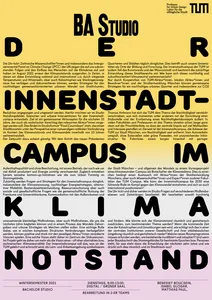
Der Innenstadtcampus im Klimanotstand
Städtebauliches Entwerfen
Wintersemester 2021 / 2022
Prof. Benedikt Boucsein, Matthias Faul, Isabel Glogar
The clock is ticking: Numerous scientists and in particular the UN's Intergovernmental Panel on
Climate Change (IPCC) are pointing out the consequences and human influence on the climate
crisis that are coming our way and have once again declared a climate emergency in August 2021.
In times in which we can follow and document this development live nationally and internationally,
among other things through rising temperatures and heat islands, but also catastrophes such as
heavy rainfall events, strategies for sustainable urban change of urban spaces, neighbourhoods
and cities oriented towards the common good become more urgent every day. This also affects
our universities as places of education and research. The inner-city campus of TUM is also part of the Kunstareal and Maxvorstadt and helps determine the future development of this urban area.
How can it develop in a sustainable and future-oriented climate-neutral way?
Only through cooperation between TUM actors, local actors and residents and Munich's urban
development can joint strategies for a sustainable urban quarter and in particular for CO2
reduction be tackled and implemented. To this end, we would like to develop fields of action,
scenarios and urban interventions for the inner city campus in the studio. The goal is a joint
“Aktionsplan” (action plan) for the next 10 years, which will also be presented to the relevant
actors as a realistic proposal. This takes place in the studio format "Final Countdown", which
further develops an urban building block from the perspective of a necessary radical change in
the context of climate emergency and climate change within 10 years.
The timing seems favourable: with the arrival of the new president Thomas Hofmann, the TUM has
increasingly committed itself to the issue of sustainability, which is currently being expressed,
among other things, with the establishment of a staff unit and the development of a sustainability
concept. In many faculties and professorships, the topic has long been at the top of the priority
list anyway, so the central impulse has met with much goodwill and interest. Meanwhile, the innercity
campus, the TUM's address to the city of Munich, is far from sustainable: surrounded by car
traffic, without solar cells or green facades, with inadequate infrastructure for bicycles, a unused
inner courtyard with little amenity quality and no shade, a campus operating and still producing a
lot of waste and energy unnecessarily. At the same time, individual bottom-up initiatives such as
urban farming student initiatives are already emerging on the main site.
In the future, questions and strategies for the inner-city campus will become urgent, especially
climate adaptation, sustainable energy strategies, alternative mobility, building stock
development, less use of resources, but also social and societal questions such as the communal
use of the open spaces and university spaces, communication with the outdoor spaces and the
city of Munich - and in general the change to a model project of a climate-neutral campus as an
ambassador of climate resilience. Achieving this requires an exchange with actors in Munich's
urban development, but also with scientists and experts from other faculties on the TUM campus.
How can the inner city campus take on a leading role in the fight against climate change by 2030
and thus also position itself internationally?
The clock is ticking and therefore we deal with questions at different scales and time frames in
the studio. We work on small-scale interventions to be implemented in the short term, but also on
strategies that can accompany us for the next few years and are intended to set targets and
urban strategies in a process of change. Positive visions that are strongly anchored in the
respective actors can play an important role in how changes are brought about in such complex
structures. Such a vision is therefore at the centre of the discussions.
The project is therefore about more than the vision of - often rather abstract or calculated -
climate neutrality. The inner-city campus should symbolise and promote what is taught and
researched at TUM as a learning and working environment. How could the climate emergency be
expressed spatially and creatively, become the defining theme? If the coming period will be one
of catastrophe and upheaval, how is this reflected spatially and design-wise in one of the central
institutions of our society in Munich and its urban environment? What new spatial programmes
will have to be invented, how will existing ones be modified and adapted? And if each
construction phase of the main site stands for certain epochs or persons, what will the
development of the next ten years stand for and how will this be expressed spatially and in the
urban space?